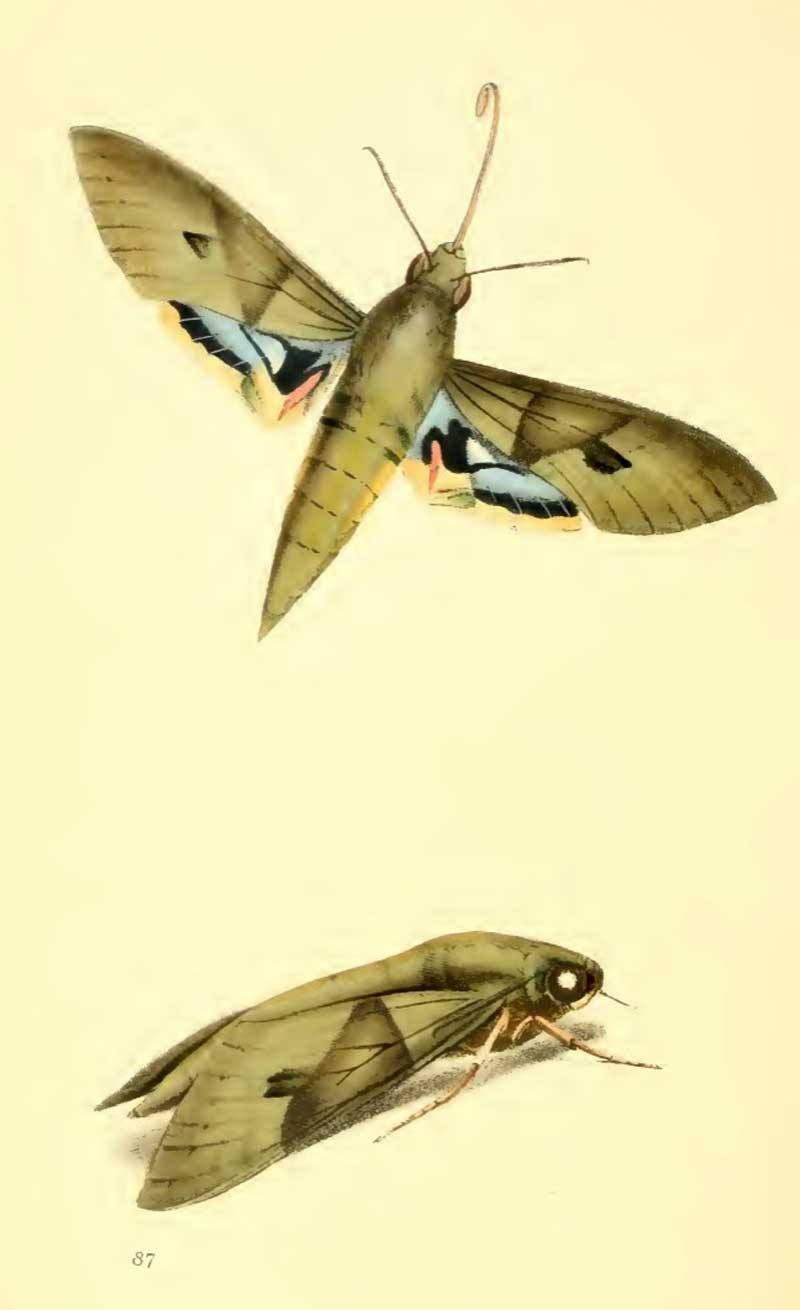
Superregnum: Eukaryota
Cladus: Unikonta
Cladus: Opisthokonta
Cladus: Holozoa
Regnum: Animalia
Subregnum: Eumetazoa
Cladus: Bilateria
Cladus: Nephrozoa
Cladus: Protostomia
Cladus: Ecdysozoa
Cladus: Panarthropoda
Phylum: Arthropoda
Subphylum: Hexapoda
Classis: Insecta
Cladus: Dicondylia
Subclassis: Pterygota
Cladus: Metapterygota
Infraclassis: Neoptera
Cladus: Eumetabola
Cladus: Endopterygota
Superordo: Panorpida
Cladus: Amphiesmenoptera
Ordo: Lepidoptera
Subordo: Glossata
Cladus: Coelolepida
Cladus: Myoglossata
Cladus: Neolepidoptera
Infraordo: Heteroneura
Cladus: Eulepidoptera
Cladus: Ditrysia
Cladus: Apoditrysia
Cladus: Obtectomera
Cladus: Macroheterocera
Superfamilia: Bombycoidea
Familia: Sphingidae
Subfamilia: Macroglossinae
Tribus: Philampelini
Genus: Eumorpha
Species: E. labruscae
Eumorpha labruscae, the gaudy sphinx, is a moth in the family Sphingidae.
Description
Wingspan of 4+5⁄16–4+3⁄4 inches (11–12 cm). Its body and dorsal forewings are a deep green color. The dorsal hindwings have purple-blue patches, yellow borders, and a red spot near the inner margin. The underside is yellow green and gray purple. Like most moths in the family Sphingidae, caterpillars pupate in burrows. This species was first described by Carl Linnaeus in his 1758 10th edition of Systema Naturae.
Distribution
It is found from Argentina north through Central America, Mexico, and the West Indies to Florida, Mississippi, South Texas, Arizona, and Colombia. Occasionally winds carry them to other places, such as Missouri, southern Michigan, Pennsylvania, Maine, and southern Saskatchewan.
Life cycle
Female adults lay their eggs on the leaves of the host plant, mainly grapes (Vitis), and vine (Cissus). Caterpillars hatch and start eating, resembling the head of a snake. When they are ready to pupate, they climb down their host plant and burrow underground. When the pupa is ready, it wiggles to the surface just prior to eclosion. The newly emerged adults then climb on a plant or some other surface, and pump fluid into their wings to extend them. Females emit pheromones at night, and males fly into the wind to pick up and track the pheromone odor plume. Adults probably feed on flower nectar.
Subspecies
Eumorpha labruscae labruscae
Eumorpha labruscae yupanquii (Kernbach, 1962) (Galápagos Islands)
References
"CATE Creating a Taxonomic eScience - Sphingidae". Cate-sphingidae.org. Retrieved 2011-10-26.[permanent dead link]
Eumorpha labruscae, the gaudy sphinx, is a moth in the family Sphingidae.
Description
Wingspan of 4+5⁄16–4+3⁄4 inches (11–12 cm). Its body and dorsal forewings are a deep green color. The dorsal hindwings have purple-blue patches, yellow borders, and a red spot near the inner margin. The underside is yellow green and gray purple. Like most moths in the family Sphingidae, caterpillars pupate in burrows. This species was first described by Carl Linnaeus in his 1758 10th edition of Systema Naturae.
Distribution
It is found from Argentina north through Central America, Mexico, and the West Indies to Florida, Mississippi, South Texas, Arizona, and Colombia. Occasionally winds carry them to other places, such as Missouri, southern Michigan, Pennsylvania, Maine, and southern Saskatchewan.
Life cycle
Female adults lay their eggs on the leaves of the host plant, mainly grapes (Vitis), and vine (Cissus). Caterpillars hatch and start eating, resembling the head of a snake. When they are ready to pupate, they climb down their host plant and burrow underground. When the pupa is ready, it wiggles to the surface just prior to eclosion. The newly emerged adults then climb on a plant or some other surface, and pump fluid into their wings to extend them. Females emit pheromones at night, and males fly into the wind to pick up and track the pheromone odor plume. Adults probably feed on flower nectar.
Subspecies
Eumorpha labruscae labruscae
Eumorpha labruscae yupanquii (Kernbach, 1962) (Galápagos Islands)
References
"CATE Creating a Taxonomic eScience - Sphingidae". Cate-sphingidae.org. Retrieved 2011-10-26.[permanent dead link]
Retrieved from "http://en.wikipedia.org/"
All text is available under the terms of the GNU Free Documentation License

